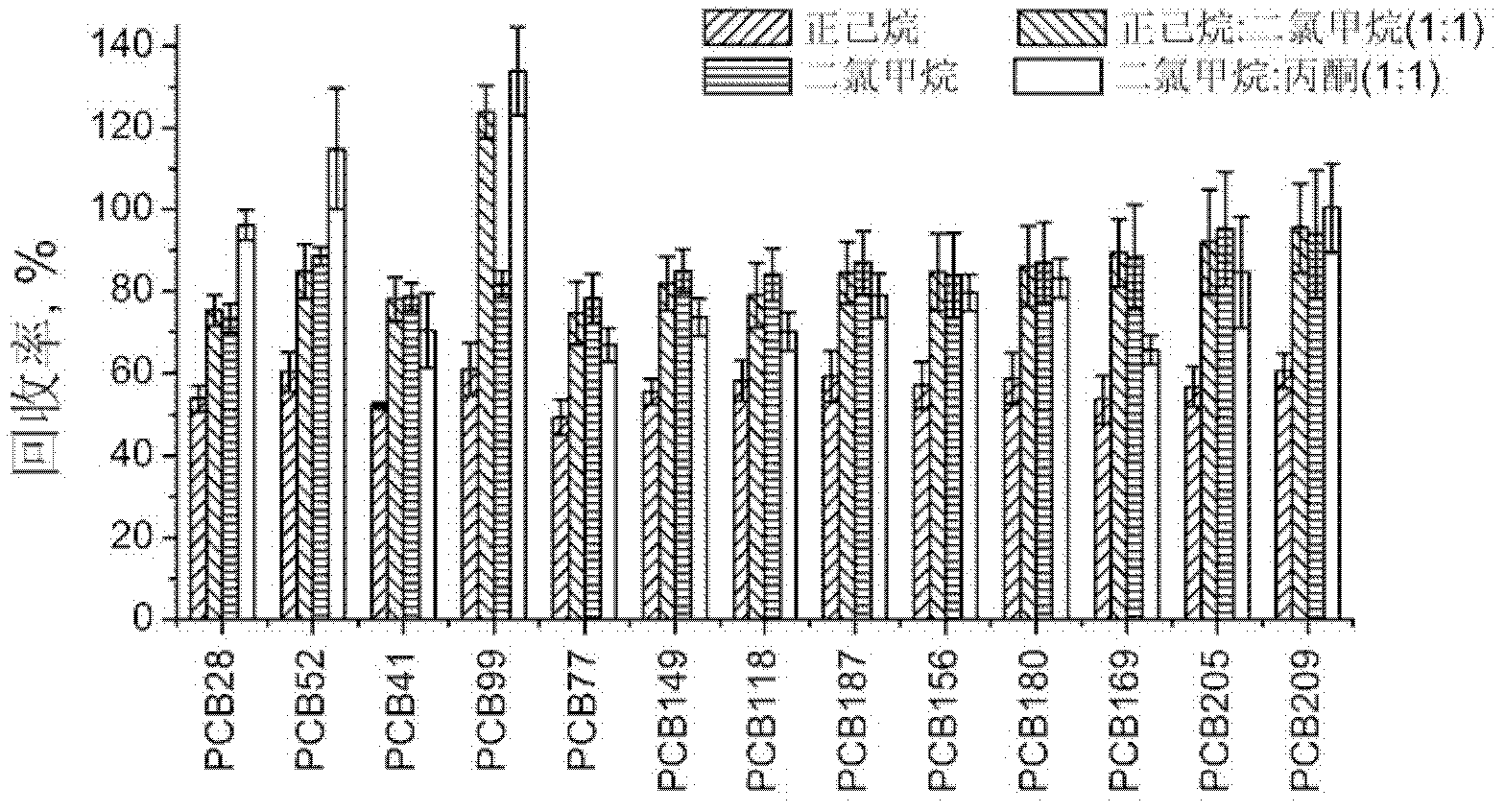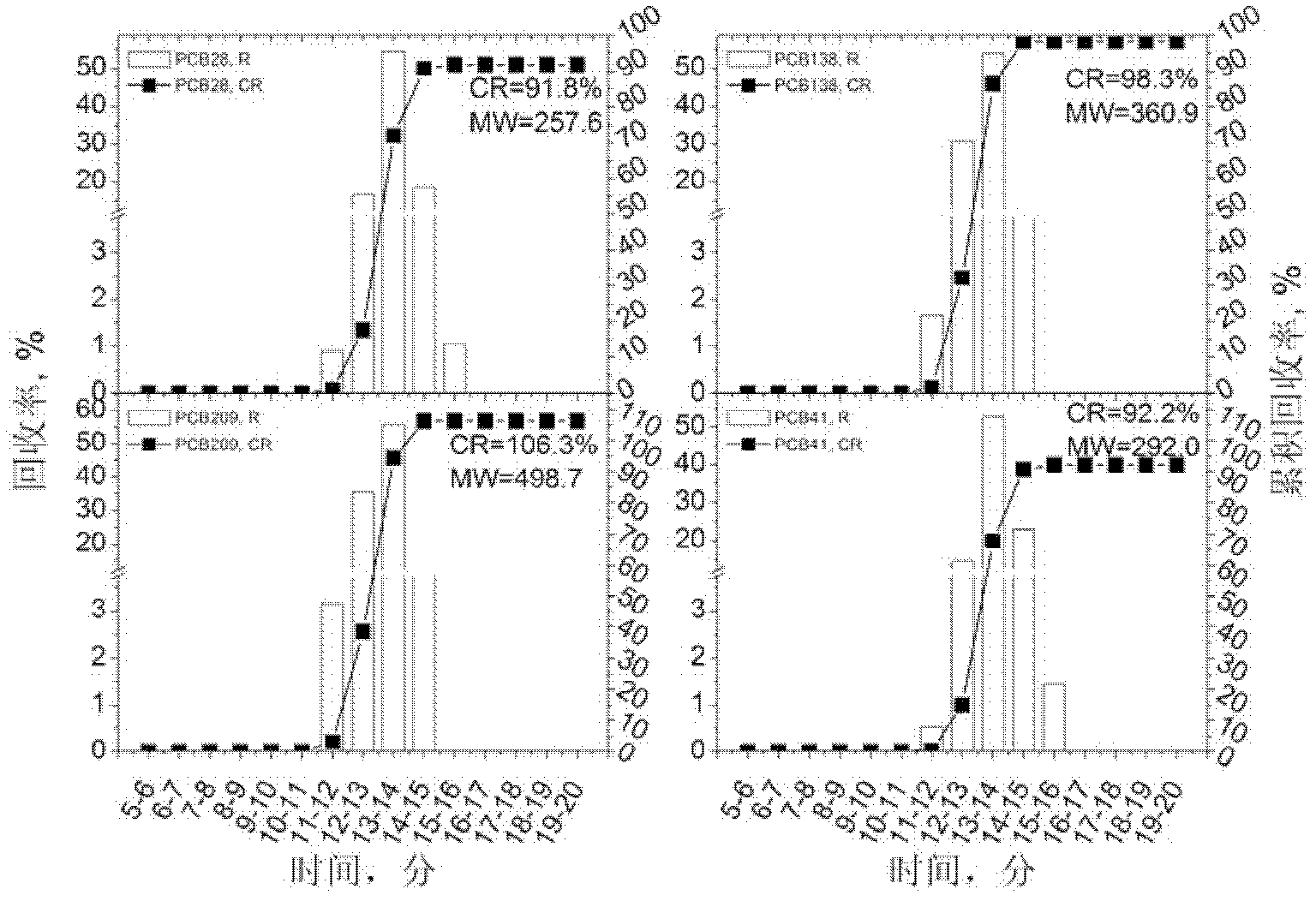A rapid qualitative detection method for polychlorinated biphenyl pollutants
A qualitative detection, polychlorinated biphenyl technology, applied in measuring devices, instruments, scientific instruments, etc., can solve the problems of time-consuming operation, high analysis cost, difficulty in identification and screening at the same time, etc., to eliminate false positives, save solvents and The effect of processing time
- Summary
- Abstract
- Description
- Claims
- Application Information
AI Technical Summary
Problems solved by technology
Method used
Image
Examples
Embodiment 1
[0025] Embodiment 1, the selection of accelerated solvent extraction conditions
[0026]Preparation of spiked soil samples: Select representative PCBs pollutants substituted by different chlorine atoms, and use the background soil (5.00g) without PCBs pollution collected in the border area of Xinjiang to carry out the spike recovery experiment to determine the accelerated solvent extraction conditions. The operation steps are as follows: Accurately weigh 5.00 g of the above-mentioned soil, add 50 μL of PCBs mixed standard (concentration is 1.2 μg / mL) to the soil, and the concentration level of each single PCBs in the soil after adding the standard is 0.012 mg / kg; Mix well, seal it tightly, and place it in a dry and cool place overnight for later use.
[0027] The extraction solvent is one of the important factors affecting the recovery rate. When other extraction conditions are fixed, four different polarities of n-hexane, n-hexane:dichloromethane (1:1, volume ratio), dichlo...
Embodiment 2
[0028] Embodiment 2, optimization of gel permeation chromatography purification conditions
[0029] According to the purification principle of gel permeation chromatography, corn oil (COFCO, China) was selected as the marker of interfering substances in the purification process, and perbromethrin (AccuStandard, the United States; molecular weight 665.01) was used as the marker of the target substance to determine The collection time to separate target substances from interfering substances. The Bio-Beads SX3 column was selected, and the peak elution time of corn oil and perbromethrin was determined under the condition that the mixture of ethyl acetate and cyclohexane with a volume ratio of 1:1 was used as the mobile phase and the flow rate was 4.7mL / min. The results showed that the peak time of corn oil was 5-9.2min, and the peak appeared at 7.1min, and the peak time of perbromethrin was 9.5-13.5min, and the peak appeared at 11.9min. Therefore, when using the above method to ...
Embodiment 3
[0031] Embodiment 3, determination of elution conditions in Florisil solid-phase extraction purification mode
[0032] Select representative PCBs pollutants substituted by different chlorine atoms to optimize the elution conditions of Florisil. The solid-phase extraction cartridge was a Florisil extraction cartridge (Supeclo, USA; 500mg, 6mL). The solid-phase extraction cartridge was activated with 6mL of methanol and 6mL of n-hexane in sequence, and the cartridge should be kept moist during the activation process. When the n-hexane liquid level in the small column was about 1 mm away from the upper sieve plate, turn off the solid phase extraction device, take 50 μL of PCBs mixed standard (concentration of 1.2 μg / mL) and dilute it to about 1 mL with n-hexane, and transfer it to the small column. Use different volumes and different types of solvents for rinsing, take the eluent into the K-D concentrator, then blow it to nearly dry with soft nitrogen and replace the solvent, and...
PUM
 Login to View More
Login to View More Abstract
Description
Claims
Application Information
 Login to View More
Login to View More - R&D
- Intellectual Property
- Life Sciences
- Materials
- Tech Scout
- Unparalleled Data Quality
- Higher Quality Content
- 60% Fewer Hallucinations
Browse by: Latest US Patents, China's latest patents, Technical Efficacy Thesaurus, Application Domain, Technology Topic, Popular Technical Reports.
© 2025 PatSnap. All rights reserved.Legal|Privacy policy|Modern Slavery Act Transparency Statement|Sitemap|About US| Contact US: help@patsnap.com



